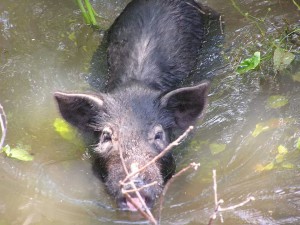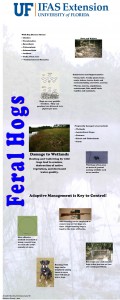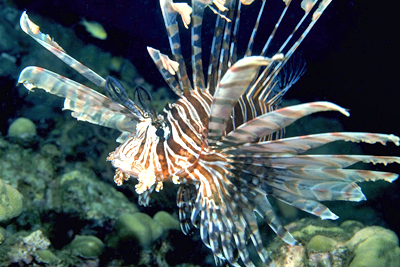March 3rd: Wild Hogs (Sus scrofa) & Lionfish (Pterois volitans):

The impact of wild hogs on the environment is soil erosion, decreased water quality, spread of other invasive plants, damage to agricultural crops, and damage to native plants and animals. Photo by Jennifer Bearden
Wild Hogs: Wild Hogs, also called Feral Hogs, are not native to the U.S. Domesticated pigs were introduced by early settlers because they could adapt to a wide variety of habitats. These pigs were kept on open ranges and used as a food source for settlers and Native Americans. In the early 1900’s, true Eurasian wild boars were introduced for hunting purposes. The population of wild hogs today are hybrids of Eurasian and domestic pigs.
Wild hogs are highly adaptable and can find suitable habitat easily. Wild hogs can be all shapes, sizes and colors since they are hybrids of many different breeds. Wild hogs sometimes resemble their domestic relatives but sometimes resemble their Eurasian backgrounds.
Wild hogs are probably the most prolific large mammals in the world. They reach sexual maturity at a young age. Females have multiple litters of 3-8 piglets per year. Natural mortality rates are low. Wild hog females and young live and travel in groups called sounders. Sounders typically have 1 to 3 adults and several young. When females reach maturity, they either stay with the sounder or they go out and form a new sounder with other young females. Young males leave the sounder alone at about 16 months.
Wild hogs are opportunistic omnivores that feed by rooting and grazing. This rooting behavior is why we consider them to be a pest. The impact of wild hogs on the environment is soil erosion, decreased water quality, spread of other invasive plants, damage to agricultural crops, and damage to native plants and animals. They have been documented as threats to threatened and endangered species. They can significantly impact populations of reptiles, amphibians, small mammals, ground nesting birds and even deer.
a pest. The impact of wild hogs on the environment is soil erosion, decreased water quality, spread of other invasive plants, damage to agricultural crops, and damage to native plants and animals. They have been documented as threats to threatened and endangered species. They can significantly impact populations of reptiles, amphibians, small mammals, ground nesting birds and even deer.
Wild hogs pose a health risk to humans because they can carry numerous diseases and parasites. Care should be taken when handling wild hogs. Wear gloves, cover any open wounds, and wear clothing that can be cleaned thoroughly. Human hunting is the most significant cause of mortality in wild hogs, although hunting alone will not control hog populations in a good habitat. The most effective way to remove wild hogs from a location is a combination of trapping and shooting.
In Florida, wild hogs may be hunted year round on private land (with permission of the landowner) and at night with no permit required. Hogs may be trapped year round. Wild hogs cannot be trapped and released onto public land. Trapped wild hogs can only be transported with a permit from FDACS) to slaughter or to an approved Feral Swine Holding Facility. For more information on Wild Hogs, go to: http://edis.ifas.ufl.edu/uw322 and http://www.myfwc.com/hunting/by-species/wild-hog/. For more information on Wild Hogs, go to: http://edis.ifas.ufl.edu/uw322
For more information contact the author Jennifer Bearden, Agriculture Extension Agent, 850-689-5850.
Lionfish: The Red Lionfish are a predatory reef fish that are non-native invasive species and have spread throughout Florida Waters. They are members of the family Scorpaenidae, all members are venomous and the lionfish is no exception. This fish is relatively small typically ranging from 12-15 inches in length and have a zebra-like appearance with long, showy pectoral fins. They have a row of long, dorsal spines that contain venom glands. Their native range is the South Pacific and Indian Oceans and preferred habitat is on offshore reef structures. These fish are considered to be voracious eaters feeding on native fish, reducing vital native populations, and competing for food with native fish such as grouper and snapper.
With few predators, these fish are thriving in Florida waters, even in the northern Gulf of Mexico. They reproduce often, sometimes all year, with their eggs hatching after about two days. They also consume a variety of local species, causing 80% decline in reef fish recruitment and loss of some economically important species. These fish are able to expand their stomachs for large meals and can survive starvation for over 12 weeks. These fish are an invasive species in our local waters and removal is encouraged. The most effective control of this species is removal by human. These fish are cryptic and nocturnal so locating them can be tricky. Spearfishing is the method of choice, since lionfish rarely bite a hook and line. Florida Fish and Wildlife Commission (FWC) changed regulations to increase harvesting opportunities. Such changes include no requirement for a recreational fishing license when using spearing devices (pole spear, a Hawaiian Sling, handheld net, or spearing devices marked for use on lionfish), and no recreational or commercial bag limit, though recreational fishing license is required for other fishing methods. Check the FWC regulations before fishing or diving for these species.
Lionfish are venomous, must be handled carefully, venom glands occur on the dorsal, pelvic and anal spines. Lionfish sightings should be reported at 877.786.7267, if stung seek medical attention as soon as possible. Rarely are stings fatal unless the person has an allergy to the venom. The Poison Help Hotline can be reached at 800.222.1222. Sighting information is being collected to track the movement of these species. Fill out the online report on the USGS website or the REEF website. Stay up to date on research as it pertains to this species at www.flseagrant.org. For locals you can report sighting also at www.lionfishmap.org.
For more information contact the author Brooke Saari, Sea Grant Marine Science Extension Agent, 850-689-5850.
Posted: March 14, 2014
Category: Invasive Species, Natural Resources
Tags: Fish, Hogs, Invasive, Lion, March, Panhandle Outdoors, Species, Wild


